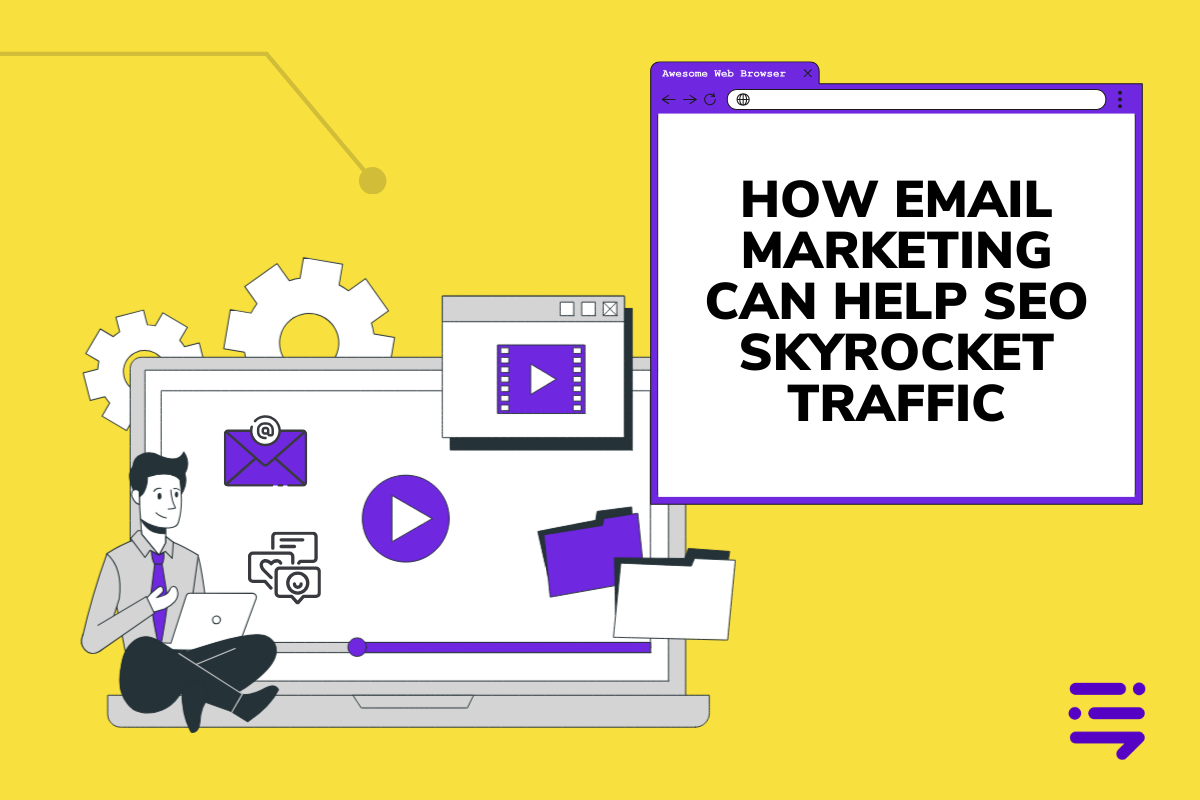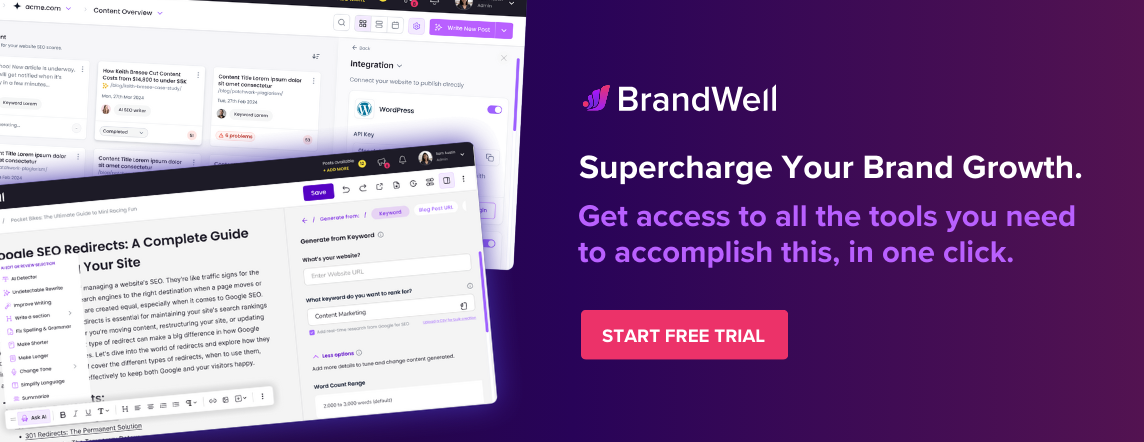Discover top guides, trends, tips and expertise from AIO Writers
How Email Marketing Can Help SEO Skyrocket Traffic
Julia McCoy
Tuesday, 14th May 2024
You’ve poured your heart into crafting amazing content, but your traffic is still stuck in low gear. What gives?
Turns out, SEO is just one piece of the puzzle. One key strategy to boost your SEO efforts is email marketing.
Believe it or not, email marketing can be a powerhouse for your SEO strategy. Cultivating a loyal subscriber base and directing targeted traffic to your site can significantly improve your search rankings, giving you an edge in the digital landscape.
Intrigued? Let’s uncover the secrets together.
Table Of Contents:
- Email Marketing and SEO: How They Complement Each Other
- How Email Marketing Can Help SEO Build Brand Awareness
- How Email Marketing Can Help SEO Improve Engagement
- How Email Marketing Can Help SEO Enhance Content Reach and Visibility
- How Email Marketing Can Help SEO Boost Rankings and Conversion Rates
- How Email Marketing Can Help SEO Establish Authority and Credibility
- Best Email Marketing Practices
- FAQs: How Email Marketing Can Help SEO
- Conclusion
Email Marketing and SEO: How They Complement Each Other
You’ve probably heard that email marketing is a fantastic way to engage your audience and drive sales. But did you know it can also give your SEO efforts a major boost?
Marketing strategies that seem worlds apart can actually complement each other perfectly.
Allow me to explain.
At first glance, email marketing and search engine optimization might seem like two completely separate entities. But when you take a closer look, you’ll see they’re more intertwined than you think.
Here’s the thing about email marketing: it’s all about building trust. When you consistently send your subscribers newsletter content that’s valuable and relevant to their needs, they start to see you in a new light. You become more than just another name in their inbox – you become a trusted resource they can turn to for guidance and expertise in your field.
And when that happens? They’re more likely to engage with your emails, click through to your website, and maybe even share your content with their own networks. All of that activity sends positive signals to search engines, which can ultimately boost your rankings.
Benefits of Integrating Email Marketing with SEO
Okay, so we know email marketing and SEO are connected. But what specific benefits can you expect from integrating the two? Here are a few big ones:
- Increased Website Traffic: When you include links back to your site in your emails, you’re encouraging your email subscribers to visit specific pages. More traffic = good news for SEO.
- Better Engagement Metrics: If subscribers are spending time reading your emails and clicking through to your site, that’s a sign of high engagement. Search engines take note of that.
- More Social Shares and Backlinks: Make it easy for subscribers to share your email content on social media and you could earn some valuable backlinks in the process.
When you combine SEO and email marketing, you’ve got a winning combo.
Better search rankings? Check.
More website traffic? You bet.
And that means more customers and more money in your pocket.
How Email Marketing Can Help SEO Build Brand Awareness
Quick question: Can you guess one of the best methods to skyrocket your brand awareness online?
If you said email marketing, ding ding ding. You’re absolutely right.
Here’s how.
Create Engaging Email Content
First things first, let’s talk about the kind of email content that actually grabs people’s attention and sticks in their minds.
I’m talking about content that’s personalized, valuable, and dare I say … fun?
Yep, even in the B2B world, injecting some personality into your emails can go a long way.
Create content that speaks directly to their specific needs, passions, and pain points, and write in a friendly, conversational manner.
One tactic I love is storytelling. Instead of just listing out features or benefits, try weaving a narrative around your product or service. Help subscribers envision how it could change their lives or solve their problems.
Grow Your Email List
Of course, creating amazing email content is just half the battle. You also need people to actually see it, right?
That’s where growing your email list comes in.
There are tons of ways to attract new subscribers, but one of the most effective is offering a lead magnet. This is a freebie — like an ebook, whitepaper, or discount code — that people get in exchange for signing up for your list.
The key is to make sure your lead magnet is something your target audience actually wants. Don’t just slap together a generic PDF and call it a day. Really think about what would be valuable to them.
Social media is a goldmine for newsletter growth. Mention it to your followers and simplify the signup process.
Feeling generous? Run a contest or giveaway – people love the chance to win something cool.
Segment Your Email List for Targeted Messaging
Okay, so you’ve got engaging content and a growing list of subscribers. Now it’s time to take things to the next level with segmentation.
Segmenting means splitting your email list based on different characteristics, so you can send the right message to the right person at the right time.
For example, let’s say you sell fitness equipment. You might segment your list into beginners, intermediate, and advanced athletes. Then you could send beginner-level content to the first group, more advanced tips to the second, and so on.
The beauty of segmentation is that it helps you build deeper relationships with your subscribers. When they feel like you really “get” them and their needs, they’re more likely to engage with your emails and ultimately, buy from you.
So don’t be afraid to get granular with your segments. The more specific you can get, the better.
How Email Marketing Can Help SEO Improve Engagement
You know how email marketing can help SEO? Getting a ton of traffic that sticks around.
Email marketing is your ticket to on-site engagement stardom. You’ll be the matchmaker, pairing your audience with the pages they can’t resist. And when search engines see how much your visitors love your site, they’ll have no choice but to give you the recognition you deserve.
Drive Traffic to Your Website
Targeted email campaigns can drive a flood of interested visitors straight to your virtual doorstep.
The key here is to be strategic about the links you include in your emails. Don’t just throw in a generic “Click here to visit our website” call-to-action and call it a day.
Instead, think about the specific pages or posts you want to drive traffic to. Maybe it’s a new product launch, a killer blog post, or a limited-time offer. Whatever it is, make sure the email content surrounding that link is relevant and compelling.
For example, let’s say you’re promoting a new whitepaper on email marketing tips. In your email, you might include a brief teaser of what readers will learn, followed by a prominent CTA button that links directly to the whitepaper landing page.
Encourage User Interaction
Driving traffic is great, but what you really want is for those visitors to stick around and engage with your site. That’s where user interaction comes in.
One way to encourage interaction is by including CTAs in your emails that prompt readers to take a specific action on your site. That might be leaving a comment on a blog post, filling out a survey, or even just clicking through to a product page.
Want to keep visitors glued to your site? Try promoting interactive content like quizzes, polls, and calculators through email campaigns. Not only are these engaging and fun for users, but search engines also love it when people stick around longer on your site.
Just make sure whatever action you’re promoting is relevant to the email content and your overall marketing goals. You don’t want to come across as spammy or pushy.
Analyze User Behavior with Google Analytics
Of course, driving traffic and encouraging interaction is only half the battle. To really optimize your email campaigns for engagement, you need to track and analyze user behavior on your site.
That’s where Google Analytics comes in. By setting up tracking for your email campaigns, you can see exactly how site visitors from email are interacting with your content.


For example, you can see which pages they’re visiting, how long they’re staying on each page, and what actions they’re taking (like filling out a form or making a purchase). You can even set up goals to track specific conversions from email traffic.
Armed with this data, you can start to optimize your email campaigns for better engagement. Maybe you find that certain types of CTAs perform better than others, or that certain pages have higher bounce rates from email traffic. Use those insights to tweak your strategy and keep improving over time.
The more engaged your email traffic is, the better it is for your SEO.
How Email Marketing Can Help SEO Enhance Content Reach and Visibility
You’ve created an awesome piece of content. You’ve optimized it for search. You’ve promoted it on social media. But you’re still not quite reaching as many people as you’d like.
Listen up, because email marketing is about to become your new best friend. It’s like a secret weapon for your content marketing strategy, helping you get your top-notch content in front of more people than ever before.
Promote Blog Posts via Email
First things first, let’s talk about how to use email to promote your blog posts and drive more traffic to your site.
One tactic is to include a teaser of your latest post in your regular newsletter or promotional emails. Give readers just enough info to pique their interest, then include a prominent link or CTA button that drives them to the full post on your site.
You can also create dedicated email blasts for your best-performing or most important posts. This is a great way to resurface older content that might have gotten buried on your site or to give an extra push to a blog post that’s already doing well.
Just make sure the email content is compelling and relevant to your audience. Don’t just blast out every single post you publish – be selective and strategic about which ones you promote via email.
Optimize Email Content for Search Engines
Search engines can’t actually crawl the content of your emails, but that doesn’t mean email can’t help your SEO efforts.
Elevate your email content’s search engine rankings by strategically placing relevant keywords in your subject lines, headings, and body text. By doing so, you’re not only helping your subscribers quickly understand what your content is about but also signals to search engines how your emails align with their interests.
Another tactic is to include links back to your website or blog in your email content. The more high-quality, relevant links pointing to your site, the better for your SEO. Just make sure you’re linking to pages that are optimized for search and provide a good user experience.
Finally, don’t forget about alt text for images. Even though search engines can’t “see” the images in your emails, they can read the alt text. So include relevant keywords there too.
Leverage Social Media Integration
Another way to boost your content reach and visibility is by including social sharing buttons in your email content. This makes it super simple for subscribers to share your blog posts, videos, or other content with their followers on social media.
Want to give your social media channels a boost? Your email campaigns are the perfect wingman. Tuck your profile links into the footer or signature, or create an email campaign that’s all about a social media promotion or contest.
It’s a win-win – your subscribers get to join in on the fun, and you get to grow your following.
By cross-promoting on these platforms, you’ll attract a larger audience and boost your SEO. More visibility equals more organic traffic to your site.
How Email Marketing Can Help SEO Boost Rankings and Conversion Rates
Want to know the secret to skyrocketing your conversion rates and climbing the ranks in Google organic search results? It all comes down to two things: crafting irresistible calls-to-action (CTAs) and implementing SEO best practices in your emails.
Alright, listen up – I’m about to give you the lowdown.
Include Strong Calls-to-Action
Your email’s CTA is the pivotal moment that compels your reader to take action. And trust me, after analyzing countless email campaigns for my clients, I’ve found that a well-crafted CTA can make or break your conversion rates.
So what makes a CTA truly compelling? It’s all about using action-oriented language that creates a sense of urgency and clearly communicates the value of clicking through.
Instead of generic phrases like “Click here,” try something more specific and benefit-driven like “Claim your 50% discount now” or “Get your free e-book.”
Get playful with your CTA design and placement. Bright, bold colors can make your buttons pop, while smart positioning grabs attention. Test out different looks to discover the perfect formula that skyrockets your click-through rates.
Monitor SEO Performance
Of course, getting those clicks is just the first step. To really gauge the impact of your email campaigns on your SEO, you need to track your performance metrics religiously. I’m talking website ranking, organic traffic, bounce rates, time on site – the whole shebang.
I swear by Google Analytics for tracking the performance of my email campaigns. It’s simple: create custom tracking URLs for each email link, and voila. You can watch in real time as your campaigns drive traffic and engagement to your website.
But the real magic happens when you explore your Google Search Console data, where you can witness the impact of your emails on your keyword rankings and organic visibility.
Implement SEO Best Practices in Emails
You might be thinking, “I thought search engines didn’t directly index emails.”
You’re spot on. But here’s the thing: just because they’re not indexed doesn’t mean you can’t leverage your emails to bolster your overall SEO strategy.
One simple but effective strategy is to include relevant keywords in your email subject lines, headings, and body copy. This not only helps your emails feel more targeted and relevant to your subscribers, but it also ensures that any links or content shared from your emails will be associated with your target keywords.
Another often-overlooked opportunity is to optimize your email templates for mobile devices. With more and more people checking email on their smartphones, having a mobile-friendly design can significantly boost your click-through rates and on-site engagement — both of which are positive signals for SEO.


How Email Marketing Can Help SEO Establish Authority and Credibility
Let’s face it – the inbox is a crowded and competitive space. To really stand out and earn your subscribers’ trust, you need to position yourself as a credible authority in your industry. And one of the most effective ways to do that is through your email content.
Provide Value-Packed Content
Your subscribers are drowning in a sea of promotional emails. To stand out in their inbox, your email marketing needs to offer something truly valuable. Whether it’s insider tips, exclusive offers, or personalized content, every email should be a treasure trove of information that keeps them engaged and excited to hear from you.
What does that look like in practice? It could be an in-depth tutorial on a topic your subscribers are struggling with, a roundup of industry news and insights, or even just a personal story or case study that illustrates a key lesson.
The key is to focus on providing content that is genuinely useful, informative, or entertaining — not just a thinly veiled sales pitch.
Want to create an email newsletter fast? Watch here:
Showcase Your Expertise and Thought Leadership
In addition to offering practical value, your email content is also an opportunity to showcase your unique expertise and perspective as a thought leader in your space. This could mean sharing your take on a controversial industry topic, offering predictions or analysis on emerging trends, or even just pulling back the curtain on your own processes and strategies.
By consistently delivering high-quality, thought-provoking content, you’ll gradually build a reputation as a trusted expert and go-to resource in your subscribers’ minds. And that kind of brand reputation is invaluable for both your email engagement and your search visibility.
Build Trust with Consistent Communication
One often overlooked aspect of building credibility through email is being consistent and reliable in your communication. Clearly communicate what kind of content your subscribers will receive and how often they’ll hear from you. Then, follow through on those commitments week after week.
This steadfast approach will help you establish trust and credibility with your audience over time.
Transparency and authenticity in your messaging are also essential. Acknowledge any challenges or mistakes you’ve made along the way. Consistently put your subscribers’ needs and interests at the forefront of your communication.
This approach to trustworthy communication, maintained over time, will help you establish deep, meaningful connections with your subscribers – connections that inspire long-lasting brand loyalty and transform them into passionate advocates.
Best Email Marketing Practices
We’ve gone over a bunch of ways to leverage email marketing for SEO, but before we call it a day, let’s talk about some best practices to adopt in your email marketing strategy.
Steer Clear of Spammy Tactics
First and foremost, resist the temptation to take shortcuts or resort to spammy tactics in your email campaigns. That means no purchasing email lists, no misleading or sensationalized subject lines, and no hiding unsubscribe links in 6-point font at the bottom of your emails.


Shady tactics like buying email lists or sending unsolicited messages may seem like a quick fix, but they’re actually a one-way ticket to email marketing disaster. Not only are these practices unethical and often illegal, but they’ll also wreck your deliverability rates and ruin your sender reputation faster than you can hit “send.”
Instead of risking it all, focus on growing a genuinely engaged, opt-in subscriber list through honest and transparent methods.
Maintain Good Email List Hygiene
On a related note, it’s crucial to regularly clean and maintain your email list to ensure you’re only sending to active, engaged subscribers. This means promptly removing any hard bounces or unsubscribes, re-engaging inactive subscribers with a targeted campaign, and periodically purging any chronically unengaged contacts.
Keeping your list clean not only helps you avoid triggering spam filters but also gives you a more accurate picture of your true email performance and ROI.
Plus, it ensures that every email you send is going to someone who actually wants to hear from you — which is the foundation of any successful email relationship.
Comply with Email Marketing Regulations
Finally, make sure you’re staying up-to-date and compliant with all relevant email marketing laws and regulations, such as the CAN-SPAM Act, GDPR, and CCPA. This means including a clear unsubscribe link in every email, providing a valid physical mailing address, and being transparent about any tracking or data collection practices.
Getting explicit permission from your subscribers and respecting their choices about how often they want to hear from you and what kind of content they want to receive is a must.
It’s not just about following the law – it’s about building a relationship of trust with your audience. When you show your subscribers that you value their privacy and preferences, they’ll be more likely to stick with you for the long haul.
Here’s the secret to email marketing success: treat your subscribers like the VIPs they are. Craft every message with their needs and interests in mind, and always aim to over-deliver on value.
When you consistently show up with authority and authenticity, you’ll foster relationships that go way beyond the inbox.
FAQs: How Email Marketing Can Help SEO
Does email marketing help with SEO?
Email blasts can’t directly boost your Google rank, but they drive site visits and amplify content reach, indirectly lifting SEO.
What are the benefits of email marketing?
Email campaigns engage subscribers, build brand awareness, and increase conversions by keeping your audience tuned into what you’re doing.
How is email marketing helpful in digital marketing?
Emails fuel digital strategies by nurturing leads and encouraging clicks back to your website. This boosts both visibility and engagement.
Conclusion
How can email marketing help SEO? By growing your subscriber list, sending targeted campaigns, and using email to promote your best content, you can drive a steady stream of engaged traffic to your site. The more visitors you attract, the higher your search engine rankings will climb.
It’s a win-win situation – not only will you see an uptick in organic traffic, but you’ll also have the opportunity to forge meaningful connections with your readers, transforming casual browsers into devoted followers.
So go ahead and put email marketing to work for your SEO.

UNLOCK YOUR POTENTIAL
Long Headline that highlights Value Proposition of Lead Magnet
Grab a front row seat to our video masterclasses, interviews, case studies, tutorials, and guides.



